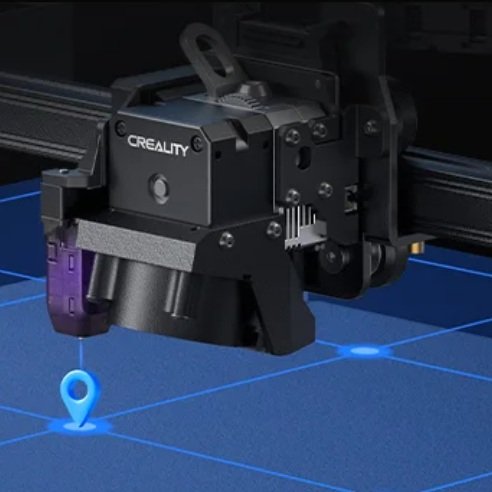This week, Creality announced their newest large format 3D printer, the CR-M4. This printer aims to add some of the new features they have introduced in the Neo and S1 series printers into the large format space. Like the CR-10 Max, the CR-M4 has a build volume of 450 x 450 x 470 mm. While not as big as the now-dated CR-10 S5 (500mm cubed), it is still one of the largest on the market.
The new Creality CR-M4 includes a number of updates over its predecessor.
Creality’s previous iteration in the large format category, the CR-10 Max.
In the past few months, it has been increasingly difficult to find the CR-10 Max for sale, so we are hopeful that this printer will bring back the large format options to the major marketplaces like Amazon. The current MSRP is said to be $1,099 USD, but this could change as the printers become available in stores.
Notable Features
The most notable update to the Creality CR-M4 is the use of the Sprite direct drive extruder, which we have used extensively with our Ender 3 S1. We have been very impressed with in terms of reliability, ease of use, and quality of the Sprite (more detail on the Sprite in our teardown here). We’ve been printing with it for approximately 6 months of heavy use and have yet to have any issues with jamming or any other maintenance concerns. Furthermore, the CR-M4 is using the all metal version of the Sprite, which means it can print higher-temperature filaments like nylon. Creality is also planning to release a large zip-up enclosure which is needed for printing Nylon or ABS. We’re excited to see the Sprite make an appearance on this printer.
The CR-M4 uses the Sprite extruder with auto bed leveling, which is a very reliable combination.
The hot end also appears to be a volcano style hot end, with a larger heated end to allow for faster flow rates. It looks like it uses standard nozzles, but Creality has not stated either way. This is especially nice to see on large printers, where you will typically be using a larger nozzle and printing with higher flow rates. A new fan duct is also present to distribute the part cooling around the nozzle. The Sprite extruder cooling is already very good, so we aren’t sure how much value this will add.
In contrast, the CR-10 Max used a standard-style hot end, but with special nozzles that are only shared with one other printer, the CR-10S Pro V2. This has been an annoyance for us with our print farm, because we’ve had to maintain a separate set of replacement nozzles and hot end parts for the CR-10 Max. Here’s to hoping the hot end on the new CR-M4 uses standard parts shared with the rest of Creality’s modern lineup.
The volcano style high flow hot-end will be a nice feature if you are printing with larger nozzles at higher flow rates.
The CR-M4 features an updated fan duct that routes the air around the nozzle.
Another interesting addition is the use of linear rails for the Y axis motion instead of the usual wheels on aluminum extrusion. We have not had any issues with the rubber wheel system on our CR-10 Max, but linear rails may improve the print quality and allow for higher print speeds. Similar to the CR-10 Max, the CR-M4 includes Z stabilization rods, which we have found to make an appreciable difference when you are printing taller parts by ensuring the gantry stays rigid.
Linear rails are typically more reliable than previous motion systems, but they only appear on the Y axis here.
Another way that Creality is modernizing the CR-M4 is the inclusion of their print cloud and wireless printing that we have previously seen on the CR-10 Smart series printers. Older Creality 3D printers required using either a USB or SD card connection, but the wireless integration will allow you to control the printer over WiFi or an internet connection. It also features a touchscreen side-mounted LCD, but that’s not especially new here—the CR-10 Max included a touch screen as well and had an integrated unibody style.
The printer also uses a removable magnetic bed, which is an improvement over the rigid CR-10 Max bed. We replaced our Max bed with glass because parts were hard to remove from the stock bed. In that respect, the bed on the CR-M4 may not be much better, since it still uses the PC material (although it may be a bit easier than it was on our CR-10 Max, since the bed surface is removable). We recommend using a glass or PEI bed for this type of printer, if you can find one in the correct size.
The flexible bed is an improvement over the CR-10 Max, but we still think part removal will be a challenge, especially with larger parts with a lot of surface on the bed.
Our Thoughts on the Creality CR-M4
We think the new features of the CR-M4 and its large build volume make it a compelling new large format 3D printer, and we are looking forward to seeing this printer more widely available than the CR-10 Max. We are also happy to see that the price has not increased from the CR-10 Max, despite the many new features. If you are looking for a large build volume printer, there are few other options below this price point, and none with the same set of modern features.
Similar to what Creality has been doing in its smaller 3D printer lines with the modern Neo series, the CR-M4 looks to be their latest step in catching their 3D printers up to the leading features of the competition while still retaining the affordable pricing that originally drew many of us to the Creality brand.






